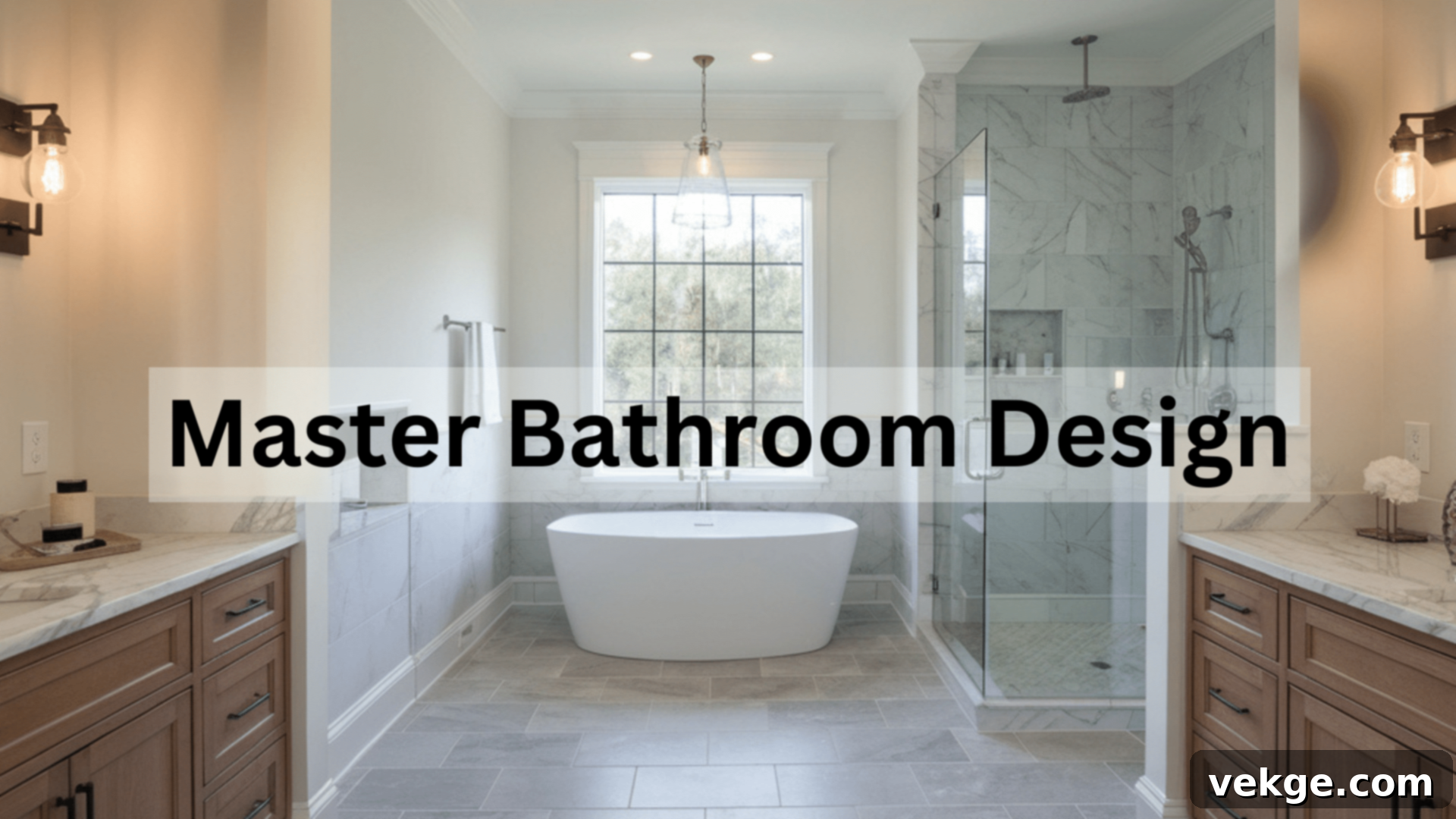Designing Your Dream Master Bathroom: Modern Trends, Layouts, and Eco-Conscious Choices
Designing a master bathroom that truly suits your needs and style transforms an everyday space into a personal sanctuary. A thoughtfully planned bathroom seamlessly blends essential functionality with ultimate comfort, creating an environment that efficiently supports your daily routine while also offering a serene retreat for relaxation and rejuvenation. Whether you’re embarking on a brand-new construction project or undertaking a significant renovation of an existing bathroom, the core principle remains the same: it’s about making deliberate choices for the right layout, features, and materials that genuinely reflect your unique personality, lifestyle, and aesthetic preferences.
The possibilities for master bathroom design are virtually endless, ranging from serene, nature-inspired aesthetics that bring the outdoors in, to opulent luxury elements that evoke high-end spa experiences, and innovative spa-like features designed for ultimate wellness. This comprehensive guide is crafted to walk you through the latest and most impactful design trends, present practical layout ideas optimized for various spaces, and highlight eco-friendly choices that contribute to both environmental responsibility and a healthier home. Our goal is to empower you to create a master bathroom that is not only stylish and highly functional but also aligns with your budget, turning your vision into a tangible, beautiful reality.
Current Trends in Master Bath Design: Blending Comfort, Style, and Innovation
Today’s master bathroom designs are focused on creating multi-purpose spaces that perfectly combine comfort, refined style, and everyday practicality. The master bathroom has evolved significantly from its traditional role as a basic functional area into a crucial zone for personal relaxation, self-care rituals, and a luxurious escape within the home.
Nature-Inspired Designs: Bringing Tranquility Indoors

The integration of natural elements into bathroom spaces continues to grow exponentially in popularity, offering a calm, grounding atmosphere that effectively helps to reduce daily stress and enhance overall well-being. Many contemporary homeowners are now opting for authentic, responsibly sourced stone countertops and shower walls, which showcase unique, organic patterns and rich textures that add depth and character. The inclusion of warm wood accents, often seen in custom vanities, open shelving, and even ceiling details, introduces a welcoming warmth to what might otherwise feel like a cold or sterile environment.
Furthermore, carefully selected indoor plants, particularly those known to thrive in humid conditions, not only improve indoor air quality but also significantly boost visual appeal, infusing the space with life and vibrancy. Earth-tone color schemes, drawing inspiration from natural landscapes, further promote relaxation and foster a profound connection to the outdoors. These thoughtful, natural touches are capable of transforming a standard bathroom into a more organic, soothing, and aesthetically pleasing personal oasis.
Luxury Elements for Your Master Bathroom: Elevating Everyday Living
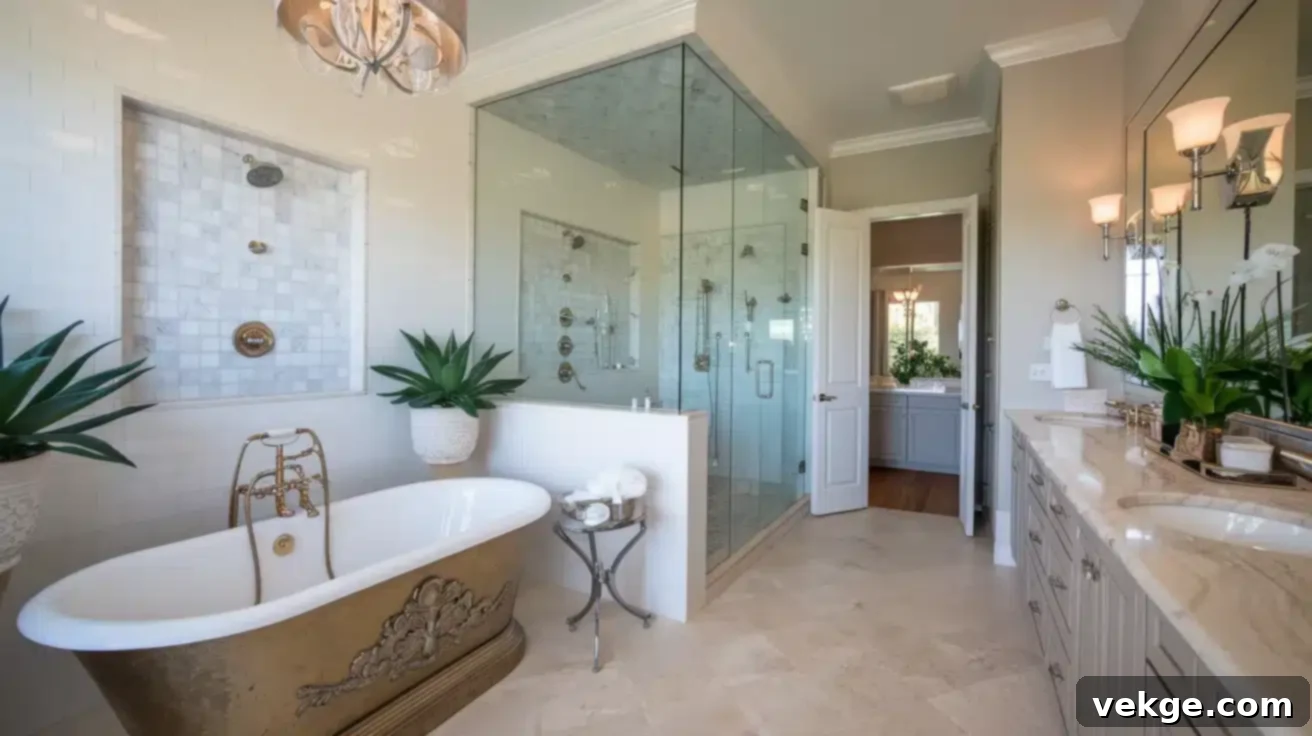
Many features that were once exclusive to high-end hotels and luxury resorts are now becoming increasingly common and even standard in modern home master bathrooms. Freestanding tubs, often crafted from elegant materials like cast iron or stone composite, serve as stunning focal points, offering both striking visual appeal and an incredibly comfortable, immersive bathing experience. Expansive glass-enclosed showers, frequently featuring multiple spray options (such as rain showerheads, body jets, and handheld wands) and minimal metal framing, create a delightful sense of openness and airiness while effectively containing water spray and simplifying cleaning.
Floating vanities, mounted directly to the wall, not only make spaces appear significantly larger and more contemporary but also greatly simplify floor cleaning. Smart mirrors, equipped with integrated LED lighting, anti-fogging technology, and sometimes even digital displays for news or weather, add a remarkable blend of advanced function and sleek modern aesthetics. These sophisticated luxury additions can dramatically improve both the usability and the overall value of a master bathroom, often without necessitating a complete structural reconstruction.
Spa-Like Features: Your Personal Wellness Retreat
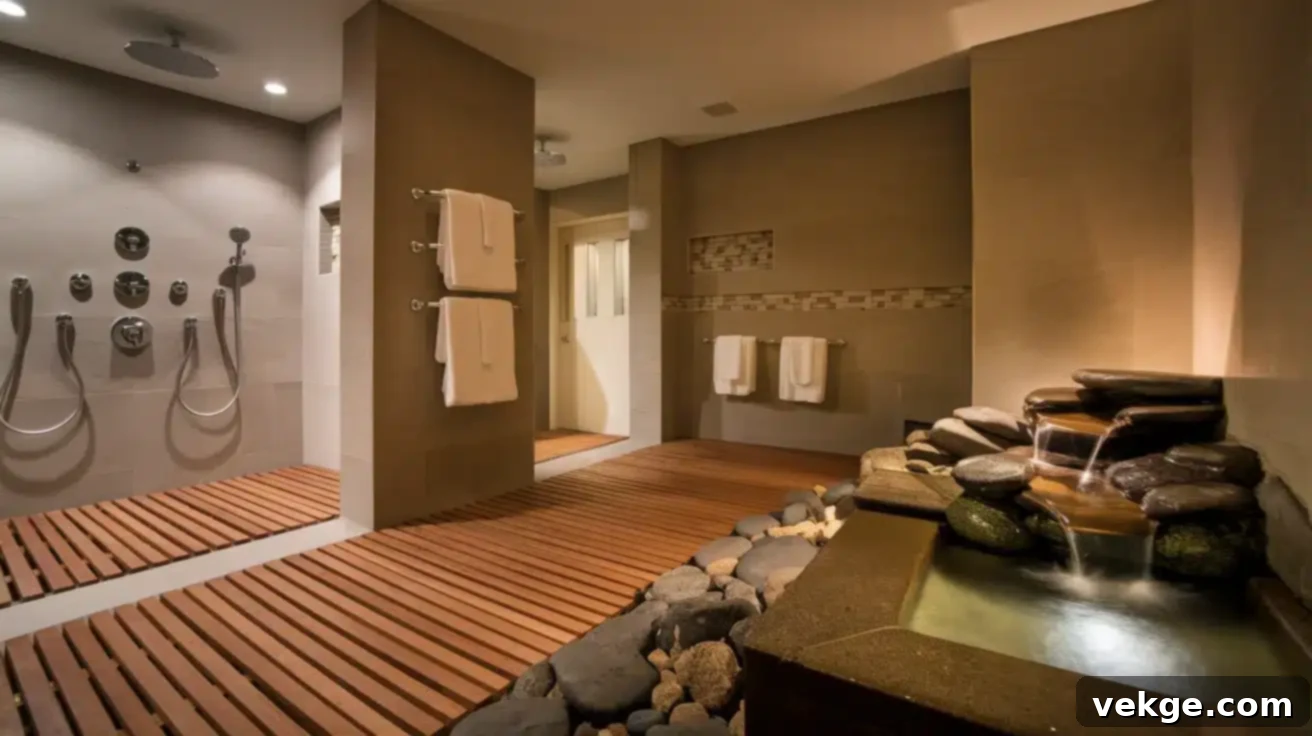
A growing number of homeowners aspire for their bathrooms to replicate the deep sense of relaxation and rejuvenation typically experienced at professional spas. Advanced heat-controlling systems, such as luxurious heated floors, convenient towel warmers, and precise temperature-regulating showers, extend comfort throughout the entire bathing experience, making even cold mornings feel indulgent. Some cutting-edge designs thoughtfully incorporate subtle water features, like small indoor fountains or trickling streams, which create calming ambient sounds and gentle visual movement, enhancing the tranquil atmosphere.
Specialized lighting systems, which can be effortlessly adjusted for different moods and activities—from bright, energizing light for morning preparation to soft, dim illumination for evening relaxation—help transition the space dynamically. Extra-large shower areas, often featuring comfortable seating options, steam functions, and multiple invigorating water sources, offer unparalleled comfort and flexibility. Thoughtful, integrated storage solutions ensure that plush towels, luxurious robes, and all personal care items are kept neatly organized and within easy, convenient reach. These meticulous additions transform ordinary bathrooms into sophisticated personal wellness spaces that actively support and elevate daily self-care routines.
Practical Layout Ideas for Master Bathrooms: Maximizing Your Space
The strategic arrangement of fixtures and elements within your master bathroom directly and significantly impacts how efficiently and comfortably you use the space on a daily basis. An optimized layout can enhance flow, improve functionality, and contribute to a more enjoyable experience.
Classic vs. Modern Layouts: A Design Dialogue
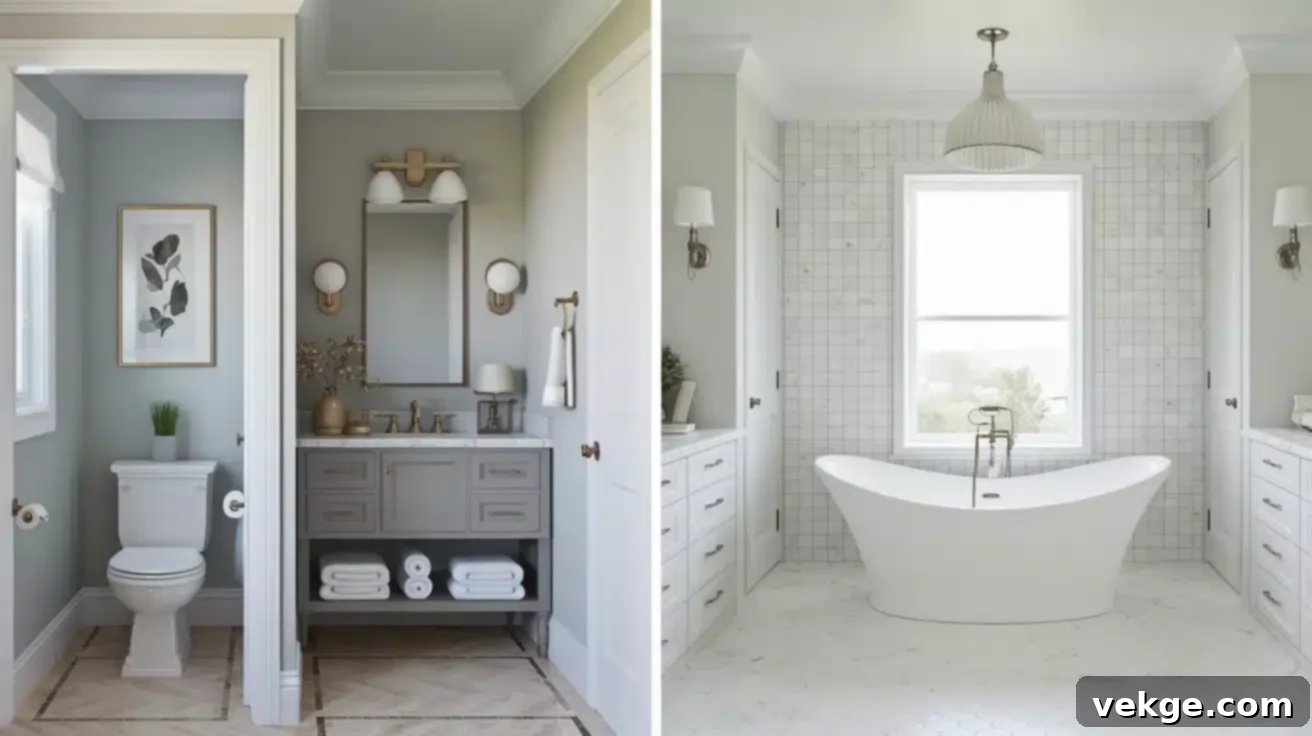
Traditional bathroom layouts typically employ physical barriers like walls or partitions to separate different elements, ensuring distinct zones for various activities. For instance, toilets are frequently enclosed in their own small water closet for enhanced privacy. Vanities usually face the main space, often with a large mirror above, and bathtubs are typically positioned against a wall. This classic approach creates clear, functional zones for different activities, providing a sense of order and privacy.
In contrast, modern layouts are characterized by fewer visual breaks and a more expansive, open floor plan. Freestanding tubs might be strategically positioned as central design features, with other elements artfully arranged around them to maintain visual harmony. These contemporary designs prioritize creating a sense of increased visual space and maximizing the influx of natural light. Ultimately, your personal daily routine, privacy preferences, and overall aesthetic vision should guide which style works best and provides the most comfort for you.
Space-Saving Layouts: Smart Design for Smaller Footprints
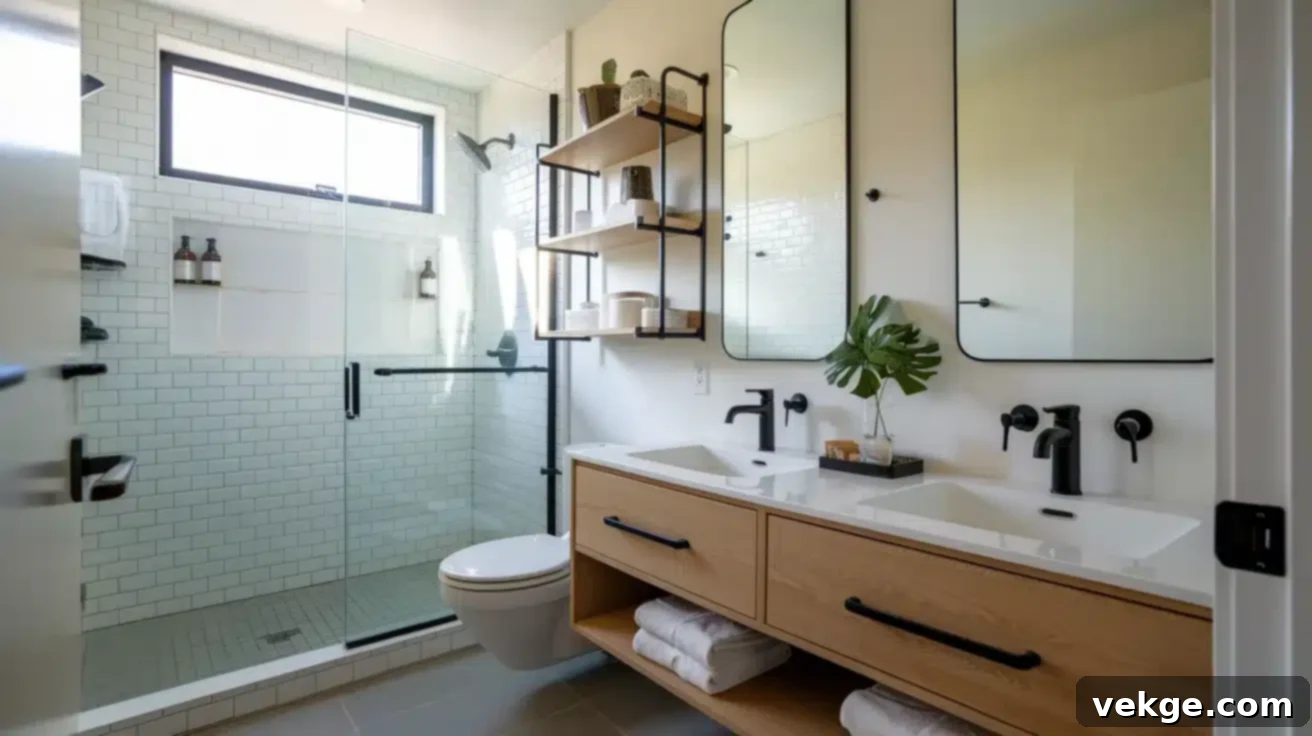
Even small master bathrooms can incorporate luxury features and feel remarkably spacious with smart, strategic planning. Corner showers are an excellent solution for utilizing space efficiently without compromising on comfort. Wall-mounted toilets and floating vanities are particularly effective, as they free up floor space, making the room appear larger and much easier to clean. Pocket doors, which slide directly into the wall, eliminate the need for swing space, offering valuable extra room.
Vertical storage solutions, such as tall cabinets or open shelving, help maximize wall space from floor to ceiling, keeping essentials organized and out of the way. Large, strategically placed mirrors create the illusion of more room by reflecting light and depth. Appropriately sized fixtures and streamlined designs maintain full functionality without overcrowding the space. Through careful planning and innovative design choices, small bathrooms can be made to feel much more generous and luxurious than their actual square footage suggests.
Open-Concept vs. Closed-Off Master Baths: Balancing Privacy and Flow

Open-concept bathrooms establish a visual connection to the adjacent bedroom by minimizing or eliminating physical barriers. This contemporary approach allows natural light to flow freely through both spaces, creating an expansive sense of openness and continuity. It works particularly well for couples who share similar schedules and privacy preferences, fostering a cohesive and integrated living experience. However, an open layout means less privacy and can lead to moisture and noise issues if not properly planned.
Conversely, closed-off bathrooms offer superior containment of moisture and humidity, provide significantly more privacy, and minimize noise disruption between spaces. They also allow for independent temperature control, which can be a practical advantage. Many homeowners opt for intelligent middle-ground solutions, such as elegant glass dividers, stylish sliding doors, or even carefully placed half-walls, which offer flexible control over the degree of openness and privacy as desired. Your ultimate choice should carefully consider your comfort with visibility, your typical household routines, and practical concerns like effective moisture and sound control.
Eco-Friendly Master Bath Design: Luxury with a Conscience
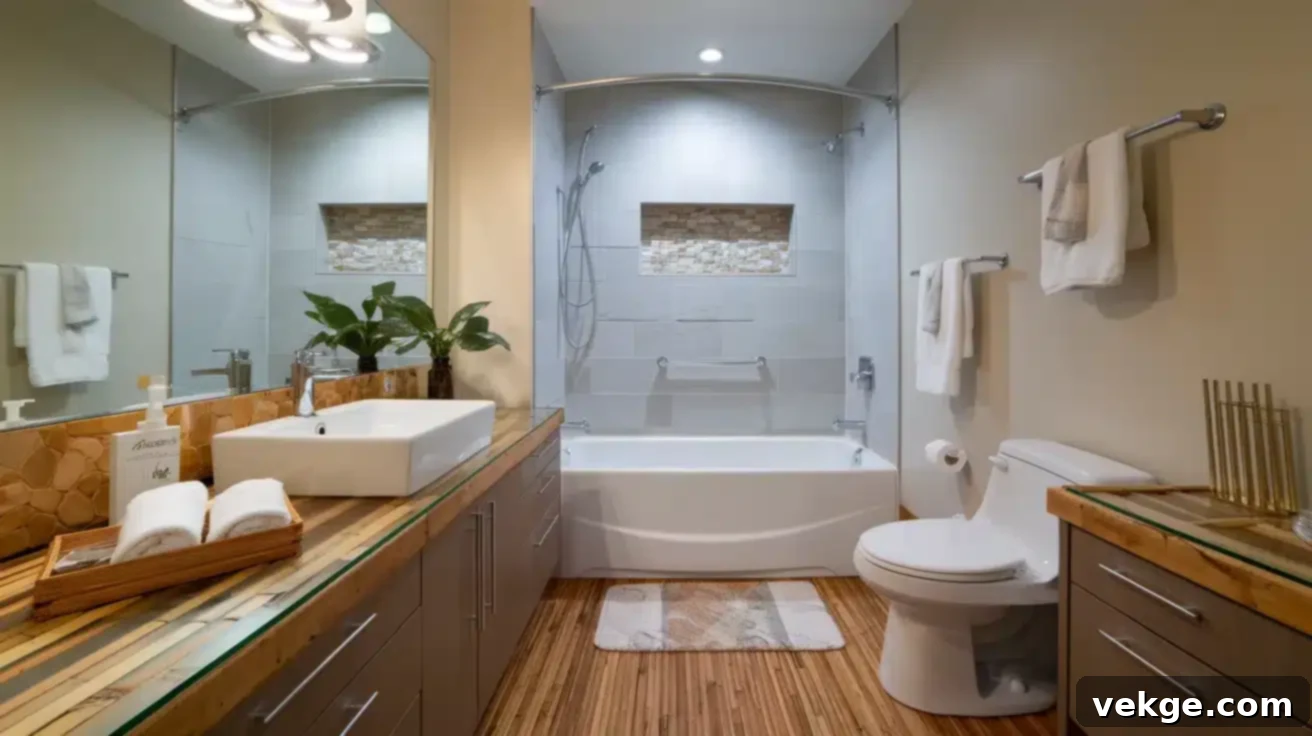
Creating an environmentally responsible bathroom involves finding a perfect balance between desirable luxury and essential conservation. Modern design options make it entirely possible to craft a beautiful, high-functioning space that also actively respects and preserves natural resources, contributing to a sustainable lifestyle.
Sustainable Materials and Fixtures: Building a Greener Bathroom
An eco-conscious bathroom begins with thoughtful and deliberate material selection. Recycled glass countertops, for instance, offer exceptional durability and a unique aesthetic while diverting waste from overcrowded landfills. Renewable flooring options like bamboo and cork provide sustainable alternatives that regrow quickly after harvest, minimizing environmental impact. Opting for FSC-certified wood cabinets ensures that the timber used comes from forests managed under responsible forestry practices, promoting biodiversity and ecological health.
Furthermore, using low-VOC (Volatile Organic Compound) paints and GreenGuard-certified fixtures helps maintain healthy indoor air quality, crucial for a family’s well-being. Incorporating reclaimed wood for accents or antique fixtures not only adds unique character and historical charm but also extends the life cycle of materials, reducing demand for new production. These mindful choices contribute to creating a bathroom that is visually appealing, healthy for its occupants, and supportive of broader environmental health goals.
Water Conservation Tips: Smart Usage for a Precious Resource
Smart water usage is paramount for preserving this vital natural resource without compromising comfort or functionality. Installing low-flow showerheads and faucet aerators helps maintain satisfying water pressure while significantly reducing overall water consumption. Dual-flush toilets are an excellent investment, allowing for appropriate water amounts for different waste types, which can save thousands of gallons yearly. Motion-sensor faucets are another innovative solution, preventing unnecessary running water when not in active use.
Considering smaller, deeper soaking tubs can provide a luxurious and relaxing bathing experience with a reduced water volume compared to conventional large tubs. More advanced solutions include simple gray water systems, which can ingeniously redirect water from sinks and showers for use in toilet tanks or for landscape irrigation. These practical and intelligent solutions dramatically cut down on water consumption while maintaining the daily comfort and convenience you expect from a modern master bathroom.
Energy Efficiency Solutions: Reducing Your Carbon Footprint
Beyond water conservation, focusing on energy efficiency can further enhance your bathroom’s eco-friendly credentials. LED lighting is a crucial component, as it consumes significantly less electricity and has a much longer lifespan than traditional incandescent or fluorescent bulbs. Maximizing natural light through larger windows or skylights can reduce the need for artificial lighting during the day. Implementing natural ventilation, such as strategically placed windows or efficient exhaust fans, helps manage humidity and air quality without relying heavily on energy-intensive HVAC systems.
For heated floors, programmable thermostats allow you to set specific schedules, ensuring heat is only used when needed, thus avoiding wasted energy. Choosing energy-efficient water heaters, especially tankless models, can provide hot water on demand, eliminating the standby energy losses associated with traditional tank heaters. These smart energy choices not only benefit the environment but also lead to noticeable reductions in your utility bills.
Key Features of the Master Bathroom: Enhancing Function and Style
A truly well-designed master bathroom integrates essential elements that strike a perfect balance between superior function and ultimate comfort. The most successful bathrooms prioritize practical needs while thoughtfully incorporating details that elevate daily use and personal enjoyment.
Custom Storage Solutions: Organized Serenity
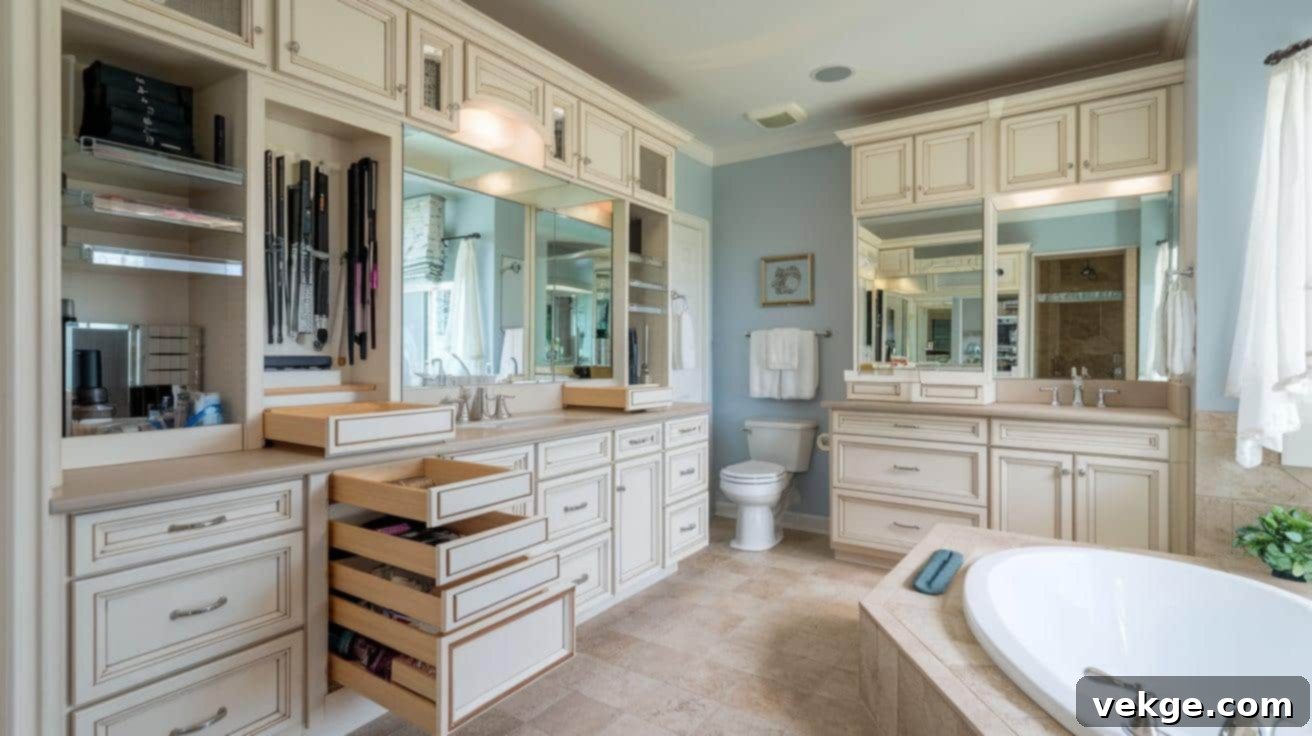
Custom cabinetry and integrated storage units revolutionize your bathroom by providing storage specifically designed to accommodate your items and daily routines. Taking precise measurements of your space and meticulously planning for your actual storage needs results in far more functional and aesthetically pleasing solutions than standard, off-the-shelf options. Consider innovative features such as pull-out organizers for smaller toiletries, vertical dividers within drawers for styling tools (like hair dryers and straighteners), and specialized sections for makeup or grooming products. Custom cabinets can also be expertly designed to work seamlessly around existing plumbing and fit perfectly into awkward or unconventional spaces that pre-made options simply cannot accommodate. This level of customization ensures every item has its place, promoting a clutter-free and serene environment.
Statement Lighting: Ambiance and Illumination
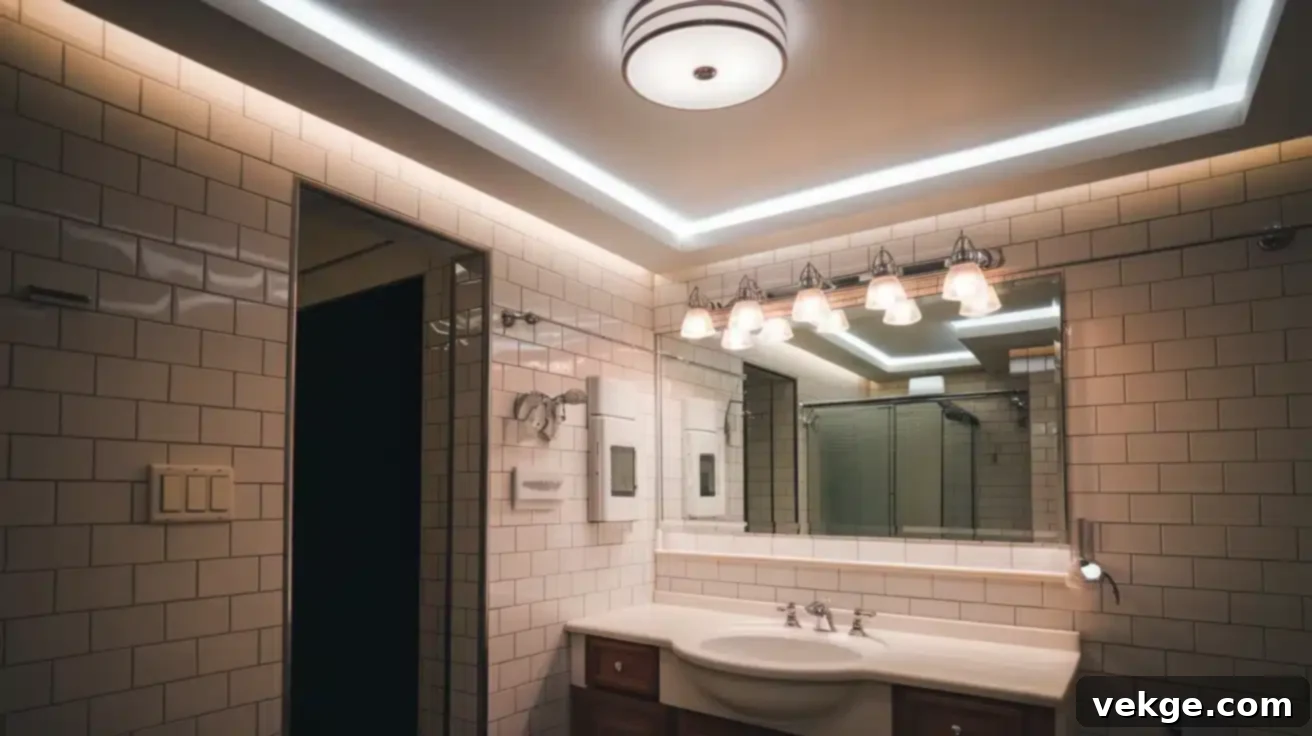
Distinctive lighting fixtures have the power to transform an ordinary bathroom into a truly remarkable space. A beautifully chosen chandelier can introduce unexpected visual interest and create an elegant focal point, particularly in larger bathrooms or above a luxurious freestanding tub. When selecting, always choose waterproof or damp-rated options specifically engineered for bathroom conditions to ensure safety and longevity. For a more contemporary approach, consider stylish pendant lights hung individually or in artistic groups over vanities or above bathtubs. These concentrated light sources not only direct attention but also provide useful illumination for daily tasks, enhancing both form and function.
Effective bathroom lighting relies on the thoughtful layering of different light types. Begin with essential task lighting positioned strategically around mirrors for practical activities such as shaving, applying makeup, or grooming. Complement this with ambient lighting, typically from recessed fixtures or a central ceiling light, to provide overall illumination. Finally, introduce accent lighting to highlight architectural features or artwork, adding depth and drama. Installing dimmer switches for each lighting type allows you to adjust the intensity, effortlessly creating various atmospheres—from bright, energizing morning light to calm, relaxing evening glows, perfect for unwinding.
Unique Textures and Finishes: A Sensory Experience
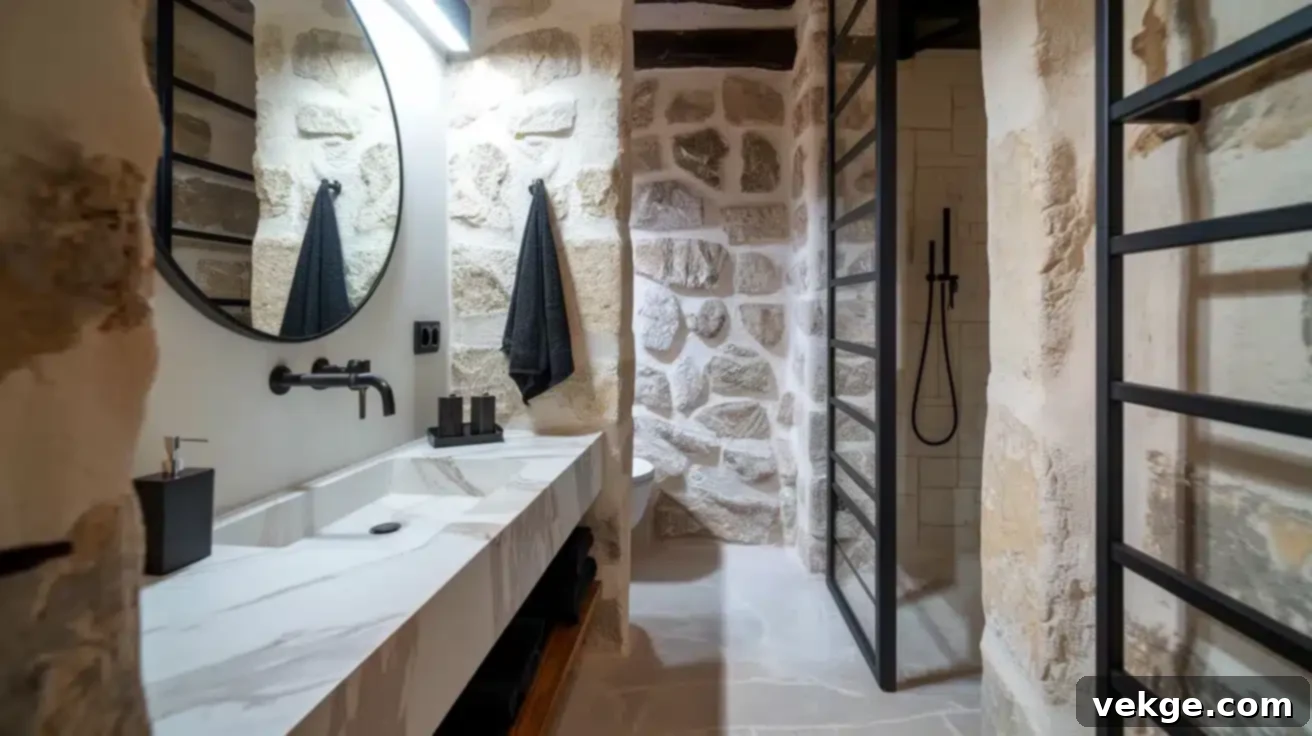
Mixing different surface textures and finishes is a sophisticated way to create profound visual and tactile interest in your bathroom. Pairing smooth, cool marble or polished quartz countertops with warm, natural wood cabinetry provides an appealing contrast that makes both materials stand out and enhances the overall aesthetic. Consider incorporating a striking stone accent wall juxtaposed against sleek glass shower enclosures, or opting for rough-textured floor tiles in harmony with highly polished chrome or brushed nickel fixtures. These thoughtful combinations add significant depth and character to your design without requiring extra physical space. Matte finishes on bathroom fixtures, such as faucets, showerheads, and hardware, offer a subtle, sophisticated alternative to traditional shiny chrome or glossy nickel. These non-reflective surfaces are not only elegant but also more effective at hiding water spots and fingerprints than their glossy counterparts. Matte black faucets and shower fixtures, in particular, create strong, modern visual lines that pop beautifully against lighter or neutral backgrounds, adding a touch of contemporary flair.
Incorporating Color: Setting the Mood
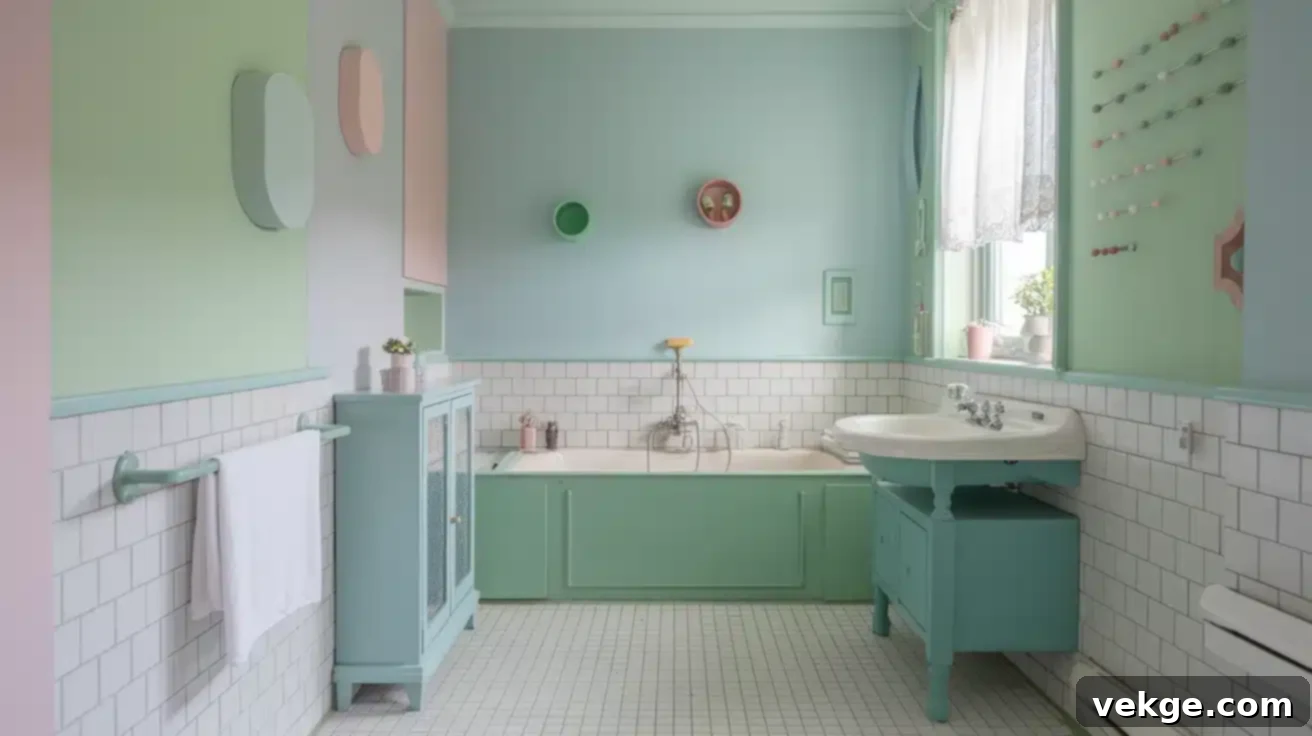
The strategic use of color plays a pivotal role in setting the desired mood and atmosphere in your master bathroom. Soft pastel colors, such as serene light blues and gentle greens, evoke a profound sense of calm and directly connect to water elements, promoting deep relaxation and tranquility. Soft lavenders and pale pinks add a touch of warmth and sophistication without overwhelming the space, maintaining an airy feel. These gentle hues are particularly effective in making small bathrooms appear larger and more open, as they reflect light efficiently. For added design flexibility and ease of change, introduce pastels through paint or easily interchangeable accessories like towels, bath mats, or decorative items, allowing you to update the look as preferences evolve.
Alternatively, bold accent features can dramatically transform a basic bathroom into a uniquely vibrant space. Consider a striking, richly colored tile backsplash behind the vanity, or a captivating shower wall adorned with patterned or brightly hued tiles that provide a powerful contrast to otherwise neutral surroundings. Even a single piece of statement artwork or a bold vanity color can infuse personality and depth. The key is to select colors that resonate with you and contribute to the desired ambiance, whether it’s a peaceful retreat or an energetic start to the day.
Conclusion
A meticulously designed master bathroom is far more than just a functional space; it’s a personal sanctuary that thoughtfully combines superior functionality, distinctive personal style, and intricate details to create an environment that truly serves and delights you every single day. From the initial layout considerations that define the flow of the room to the final material selections that dictate its look and feel, each choice you make profoundly shapes how the space operates and how it makes you feel. Incorporating natural elements, implementing custom storage solutions, utilizing strategic layered lighting, and experimenting with varied textures and finishes can utterly transform any bathroom, regardless of its size or your budget constraints.
Remember that successful master bathroom design always begins with a deep understanding of your specific needs and desires, rather than merely chasing fleeting trends. Take the time to consider how you genuinely use the space, what features are most important for your daily comfort and self-care, and which materials align best with your maintenance preferences and lifestyle. Even small, impactful changes—such as updating fixtures, introducing new accent colors, or improving the lighting scheme—can make significant differences in the overall feel and functionality of your bathroom without requiring major structural construction. Invest time in careful planning, combining practical necessities with those unique personal touches that will make the space unequivocally your own, a true reflection of your taste and a haven for relaxation and revitalization.
Frequently Asked Questions About Master Bathroom Design
Can I include a double vanity in a small master bathroom?
Yes, including a double vanity in a smaller master bathroom is certainly possible, but it requires prioritizing functionality and clever design to maximize the available space. Instead of two standard sinks with extensive counter space, consider a single trough-style sink with two faucets, which offers a similar dual-user experience in a more compact footprint. Alternatively, a longer single vanity with one sink but ample counter space on either side can provide sufficient room for two people. Ensure that you maintain a minimum of 21-inch walking space in front of the vanity for comfortable movement. Wall-mounted or floating vanities can also create the illusion of more floor space, making the room feel less cramped. Careful planning with precise measurements is essential to ensure a functional and comfortable layout.
Should I opt for a walk-in shower or a bathtub in my master bathroom?
The choice between a walk-in shower and a bathtub in your master bathroom largely depends on your lifestyle, personal preferences, and how you envision the future value of your home. Walk-in showers offer a sleek, modern aesthetic and excellent accessibility, making them a popular choice for contemporary designs and for homeowners planning for aging-in-place. They can also create a more open and spacious feel in the bathroom, especially with frameless glass enclosures. However, bathtubs, particularly deep soaking tubs, provide a luxurious relaxation experience and are often considered a significant selling point for families with young children or for potential future buyers who value the option of a bath. If space allows, a combination of both – a separate walk-in shower and a freestanding bathtub – offers the ultimate in luxury and versatility. If limited to one, consider your daily routine: do you prefer quick, invigorating showers, or do you cherish long, relaxing soaks?
How do I choose the right materials for my master bathroom?
Choosing the right materials for your master bathroom involves balancing aesthetics, durability, maintenance, and budget. For surfaces like countertops and shower walls, consider options such as natural stone (marble, granite, quartz), engineered quartz, or large-format porcelain tiles. Natural stone offers unique beauty but may require more maintenance, while quartz is highly durable and low-maintenance. For flooring, ceramic or porcelain tiles are popular due to their water resistance and vast array of styles, but consider options like luxury vinyl plank (LVP) for its warmth and ease of installation. When selecting fixtures, look for high-quality metals like brushed nickel, chrome, matte black, or brass that complement your chosen aesthetic and offer long-term durability. Always opt for moisture-resistant materials for walls and ceilings, such as mildew-resistant drywall or specialized bathroom paints, to prevent common issues in humid environments. Prioritize materials that align with your desired look, can withstand the bathroom’s environment, and fit within your financial plan.
What are the benefits of smart bathroom technology?
Smart bathroom technology offers a range of benefits that enhance convenience, comfort, safety, and even energy efficiency. Smart mirrors can provide integrated lighting, defogging capabilities, and even display information like weather or news. Smart toilets offer features such as automatic flushing, heated seats, bidet functions, and self-cleaning mechanisms, significantly improving hygiene and comfort. Thermostatic showers allow you to precisely set and maintain your preferred water temperature, preventing sudden changes and enhancing the showering experience. Beyond convenience, smart tech can also contribute to safety (e.g., motion-sensor lighting) and energy saving (e.g., programmable heated floors, water-saving features in smart toilets). These integrated technologies create a highly customized and luxurious bathroom experience, bringing cutting-edge innovation into your daily routine and potentially increasing your home’s value.
